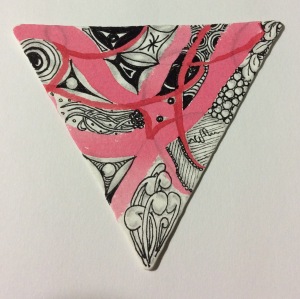About ten months ago, I came across Zentangle as I was researching forms of meditation, especially those I could somehow learn on my own. I had recently lost my mother, and I felt life imploding on me even though we had not been as close as we once were. Being still is more than difficult for me–it is impossible. I have more than a touch of Attention Deficeit Disorder (ADD) and need to move or be doing something if I want to concentrate. So most meditative methods seem to be out for me. I had thought about Tai Chi, but I live on a tiny island, where offerings are few. Then I came across Zentangle, and got interested in the idea of meditating through repetitive drawing of patterns.

No one will ever accuse me of having even the slightest artistic talents. I took drawing lessons a few years back to learn perspective and techniques; the lessons helped, but talent was clearly lacking. So Zentangle’s claim that artistic abilities were not necessary intrigued me. I had to learn more.
According to the official web site, Zentangle.com, the best way to learn the Zentangle method is to attend classes offered by a Certified Zentangle Teacher (CZT) in my area. Well, the island of St. Martin in the Caribbean Sea is small, and Zentangle hasn’t made it this far. I live in Sint Maarten, the Dutch country on this tiny island. The French side has a slightly smaller population. Even between the two countries, the total population is barely that of a small town back in the States. It is not surprising that there are no CZTs here, even though there are plenty of them in the Netherlands. Clearly, I would be on my own.
The second best method of learning to tangle, according to the web, is to purchase the official book. Instead, I bought a copy of a book called One Zentangle a Day, basing my purchase decision on the far lower cost compared with that of the official Zentangle Primer. I ordered One Zentangle from Amazon, along with the recommended pen, 3.5-inch square artist tiles, tortillions, and 2B pencils. Once I had everything together, i started experiencing Zentangle.
Each day, I poured my morning coffee and got out my book. Often, it took me longer than a day to complete a lesson, as I found myself getting frustrated with my apparent inability to draw even the simplest shapes and patterns. Clearly, I was doing something wrong, as I was not getting the expected benefits. As I “meditatively” journaled my journey into tangling on my writing blog (Write of Passage)–or maybe I was critiquing?–I began to notice a change in my attitude toward the process. It was actually working!
As I tangled my way through the book, I kept reading up on Zentangle. Finally, I broke down and purchased the official Zentangle Primer: volume 1 from the web site. Before making this purchase, I bought several e-books on tangling, and even a set of workbook-like books. By then, I had spent close to 4 times the cost of the Primer.

My work is not fancy, although I have learned to experiment with different materials and media for an occasional artistic touch. Tangles who understand the Zentangle method and process see the work for what it is and are not influenced by fancy patterns and flashy colors. That’s not to say fancy tiles have no place; it’s just that the simple process, simple tools, and simple black ink reduce the process to its essential elements–simple, controlled, relaxing, meditative strokes. The Zentangle motto is “Anything is possible one stroke at a time.” The products of advanced tanglers attests to the creative processes released by this clean and simple methodology. 
At this point, I have been tangling for ten months, and using the Primer for about half that time. When I need to touch base with my center or need to relax, I reach for a tile, my Micron pen, my 2B pencil, and a torillon. I go through the eight steps discussed in two previous posts. And I begin to lose myself in the process of Zentangle. I don’t have to be home to tangle, and the small size and simple tools are so portable that a “kit” can be carried easily in a pocket or bag so I can tangle anywhere. As I tangle, thoughts pass through my mind. As in any meditation, some are let go, others are contemplated while part of my mind focuses on drawing a pattern or two. Sometimes, I need to tangle more than one tile to get full benefit. Sometimes I lose concentration and need to set a tile aside. Sometimes, an “artsy” inspiration comes to me for later or immediate attention. Each time I create something new. Each time, I learn something new about the process, pattern manipulation, or myself. When I make a mistake, I incorporate it into the process and move on. In Zentangle, there are no mistakes, only opportunities–for growth, for change, for coping, for living, for learning.
Simple tools, simple process, celebratory appreciation, meditation–all while producing a miniature work of art.
That is why I tangle.
#
#educ_dr

